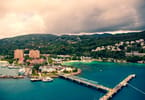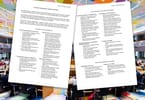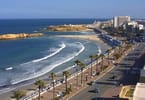Gov. Schwarzenegger’s proposal to close 220 of the state’s 279 state parks as a cost-cutting measure could be a shot in the foot of California’s economy, according to two studies. Both conclude that state parks generate more state money than they cost to operate.
Moreover, a handful of technicalities may actually render certain park closures illegal, though Schwarzenegger has expressed little interest in sparing the ax as he and his aides redraft the state’s budget and eliminate what they consider unnecessary costs—such as parks.
Locally, Henry W. Coe, Big Basin Redwoods, Portola Redwoods, Castle Rock and Fremont Peak, among several other parks, are poised to get cut from the budget. However, all of these parks have received federal support through the Land and Water Conservation Fund, enacted by President Lyndon Johnson in 1965. This fund has granted the state of California $286 million, and stipulates that all parks maintained through the use of such federal money must remain open to the public “in perpetuity.”
“I think we need to remind ourselves that protecting a place ‘in perpetuity’ means ‘in perpetuity,'” says Traci Verardo-Torres, vice-president of government affairs with the California State Parks Foundation. “If they shut these parks down, the state would be absolutely out of compliance with the agreement that they came to when they took the money.”
Eddie Guaracha, State Parks superintendent of the Gavilan Sector, says economic savings may be slight if swaths of open land such as Henry Coe are closed. However, he says, the three parks in his sector attract about 270,000 visitors each year, and societal impacts could be substantial.
While layoffs in the Gavilan Sector’s three parks—Henry Coe, San Juan Bautista and Fremont Peak—would impact just 20 people, Guaracha says, the absence of these rangers and support staff could bring about an onslaught of deer- and boar-poaching.
H.D. Palmer, spokesman for the state Department of Finance, says the governor plans to liquidate all state park general fund reserves—currently set at $143 million—over the next two years. This move, says Palmer, will leave open just 59 parks that either generate their own revenue through on-site concessions or are paid for from special funds, including the off-highway vehicle tax and the gas tax. Many of these parks are located on freshwater reservoirs and attract boaters.
This is not the first such threat to the California’s parks. In January, 2008, Schwarzenegger threatened to close 48 parks for a promised savings of $13 million. Through an aggressive “Save Our Parks” campaign, the Parks Commission averted the proposal—but only temporarily.
“When this issue came around again, frankly, it was staggering,” says Verardo-Torres, who helped lead the campaign against the 2008 plan. “I think people need to know and realize that this is a very real proposal.”
In some cases, closing the gates could mean losing parks to federal hands. In a June 8 letter to Gov. Schwarzenegger, the National Park Service’s Pacific regional director, John Jarvis, explained that closing six parks, including Point Sur State Historic Park and Angel Island State Park, would violate the Federal Lands to Parks Program of 1949. That program requires that such properties remain accessible to the public permanently. If that stipulation is violated, Jarvis warned, these parks could be transferred back into federal possession.
But even disregarding these issues, will closing state parks really save the state money? The results of a study released in 2002 by UC-Berkeley show that such action could do the opposite. It shows that for every dollar taken from the state’s general fund and used to operate state parks, $2.35 is returned to the general fund in the form of sales tax.
Another study published this June by Sacramento State University found that the average party that spends a night in a state park also spends $57 in local businesses. The report estimated that such spending by park visitors total $4.2 billion annually statewide.
Schwarzenegger and his staff, however, don’t trust those numbers, according to Palmer. Though he was unaware of the UC-Berkeley report, Palmer questioned the validity of the Sacramento State study, in which 88 percent of surveyed park visitors were California residents. It’s likely, Palmer says, that they would have spent money whether they camped the night in a state park or not.
“We don’t believe there would be a net reduction in economic activity in the state,” Palmer says.
The same report said that out-of-state visitors, who made up 12 percent of those surveyed, spend an estimated $102 million within California during their visits.
“But the study assumes they visited California only to visit the park, whereas they probably would have come anyway,” Palmer insists.
Over in Santa Cruz County, state parks make up half of the public beaches. Their closure would no doubt impact access, and the California Coastal Commission requires a permit application for any activity that affects accessibility.
Dan Carl, manager of the Commission’s Central Coast District, speculates that the Legislature could circumvent the permit application process by simply writing an exemption into law. The Commission, he says, has not yet been contacted by the state for a permit application.
To address the budget shortfalls, state Senate Democrats formally introduced a measure this spring that would, they say, solve the issue entirely. The proposal would cost California vehicle owners $1.25 per month. When it went to vote on June 26, it stalemated following a partisan vote: 22 Democrats voted in favor and 13 Republicans plus one Democrat rejected it. Four senators did not vote.
The proposal, called the State Park Access Pass, calls for a $15 annual fee for all registered vehicles in the state, of which there are roughly 28 million. Such a fund would net more than $350 million every year for California state parks, almost three times the $143 million which the governor plans to cut from the general fund. While the State Park Access Pass remains on the table of the Senate, the governor has vowed to veto it even if it gains the required two-thirds majority vote.
The State Park Access Pass too closely resembles a tax, explains spokeswoman Lisa Page—and Gov, Schwarzenegger opposes all new taxes. He is, however, “open to creative measures” by local governments that could generate revenue to pay for nearby park operations, she says.
But with one creative measure already shot from the water and likely to be tossed into the trash bin, park advocates are hoping for a surprise allotment in the general fund when the new budget is unveiled, which could occur within days. If parks get the ax, closures could begin just after Labor Day.
WHAT TO TAKE AWAY FROM THIS ARTICLE:
- Schwarzenegger’s proposal to close 220 of the state’s 279 state parks as a cost-cutting measure could be a shot in the foot of California’s economy, according to two studies.
- Moreover, a handful of technicalities may actually render certain park closures illegal, though Schwarzenegger has expressed little interest in sparing the ax as he and his aides redraft the state’s budget and eliminate what they consider unnecessary costs—such as parks.
- Another study published this June by Sacramento State University found that the average party that spends a night in a state park also spends $57 in local businesses.





















